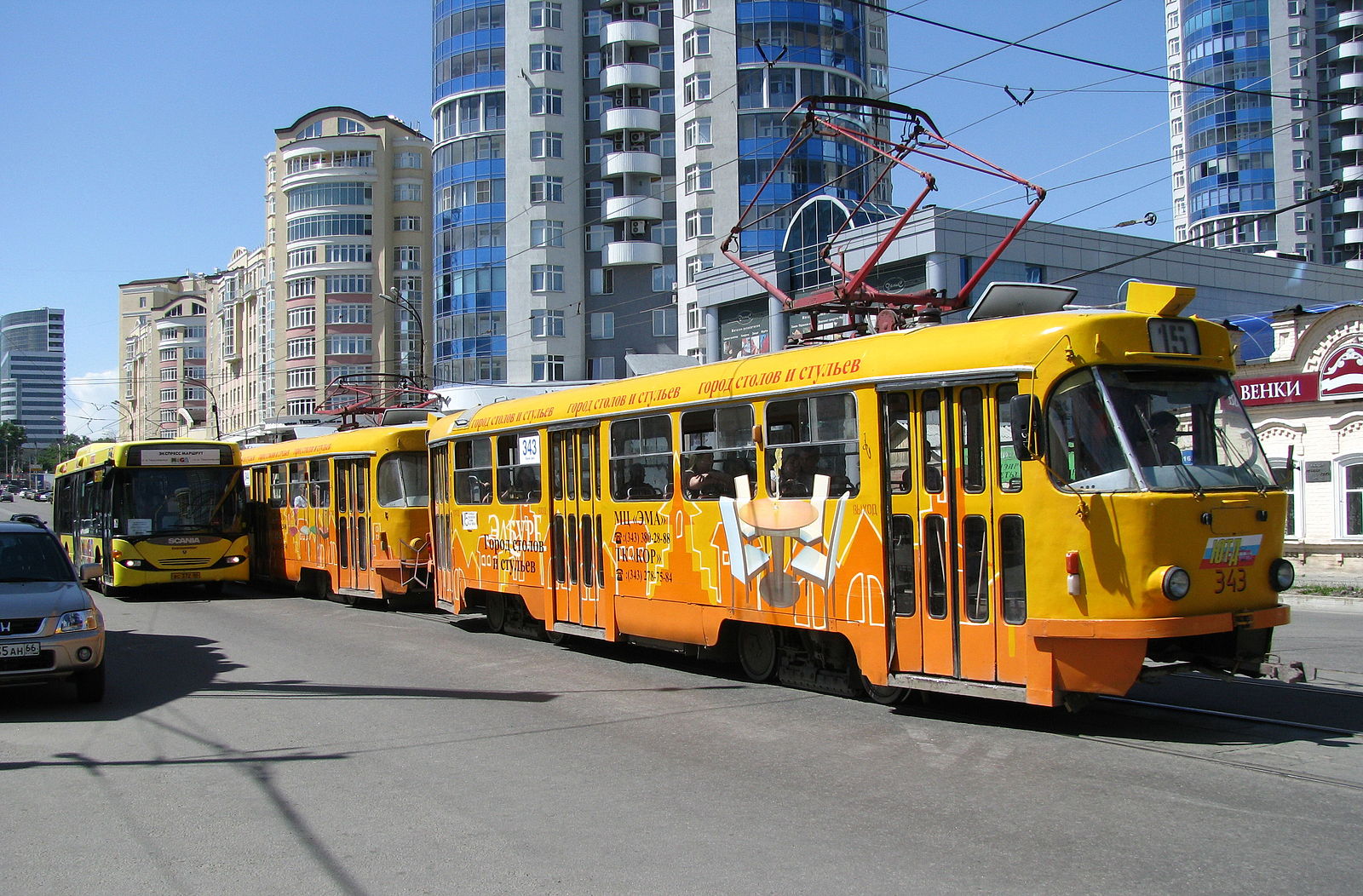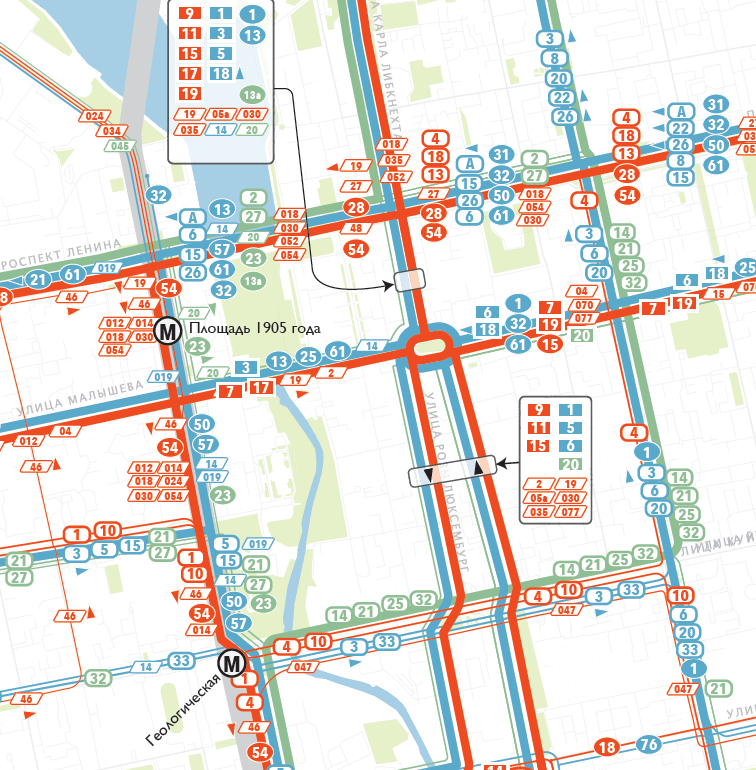Last year, I got an inquiry from Russia’s fourth largest city, Yekaterinburg, about helping them rethink their transit system. An excellent local NGO called Gorod.pro put the project together, and after the usual struggles over visas and insurance, I’m off to Yekaterinburg next week to work with City and foundation staff on new options for network design. If you read Russian, you can follow along on the project page.
We’ve laid out an initial analysis of the system in our Choices Report, which is now public. You can download it here: English. Russian.
Yekaterinburg has several transit networks, which is not necessarily better than having one. There’s a metro, a tram network, a trolleybus network, a local bus network, and a range of small-bus products, and they mostly look like they’ve been designed separately, rather than working together. There’s an emphasis on low-frequency direct services rather than high-frequency connective services, so that’s a trade-off we’ll explore.
One key thing we did was to draw what may be the first map that shows all the transit services. You can find it in the report, but here’s a slice. The colors here mean frequency (red is 15 or better, green is 30 or better, green is 60 or better). The number symbols distinguish the technologies.
We think maybe this could be simpler.
And of course, when you have a lot of infrequent lines piled up on the same long segments, it means you could afford more frequent lines if you combined them.
But it’s all about trade-offs. I ask the questions but the locals answer them. We’re happy to see people downloading and reading our Choices Report, and I’m looking forward to great conversations (in simultaneous translation) over the next two weeks.


Five years ago I had a casual look at a smaller Siberian city’s transit service and – of course – a little time in Moscow. The thing that they had in common was a variety of new and old tossed together. Infrastructure for trolleybus and tramway lines was aging and civic authorities were obviously repeating American mistakes in their rush to catch up with auto registrations. In many respects, it was a chance to visit the 1930’s as it was in North America. (One clue on a tramway ride was when my foot caught on a re-railing frog under the seat in front of me. Looking at track conditions, it was reasonable to bring it along.) Few cities had reliable ridecheck data for on-going service planning.
Nevertheless, Russians have a good record of adapting advice from foreign experts to their own situation. (Russian railways employ a blend of North American, European and original ideas.) Sometimes it takes a while to gain acceptance, but Yekaterinburg strikes me as a place interested in trying new ideas.
— rwr
The russian cities having superdense clusters of commieblocks surrounded by wilderness makes them interestingly different.
Jarrett’s principles still apply ofc, the current network looks like a mess.
This type of development reminds me of LeCorbusier:
http://www.city-journal.org/html/architect-totalitarian-13246.html
It’s been years since I read a book on Soviet town planning, but a couple of characteristics of these communities are that some amenities – especially places of worship and auto parking – were not included. Child care and basic shopping were represented. In some respects, they were similar to English town planners’ work, but on steroids (see Parkallen in Edmonton, Alberta for a Canadian scale and you’ll find an abandoned trolley coach loop for Rte S2/42 similar to these Russian districts).
These greenfield super-developments were often located for property reasons, rather than transportation reasons, here or in the Soviet Union. Rail or trolleybus access was then extended from whatever line was handy. This almost had a parallel in Edmonton light rail. Long-range planners controlled by the city planning department wanted the south side line to follow the Canadian Pacific Railway line over the High Level Bridge and then split three ways – to the University, to Kaskitayo (missing Southgate) and to Mill Woods (missing Millgate). Daytime base service on each branch would have been every 30 minutes, with evening service every 45 minutes. Reaching the UofA from the south side would have required travel across the river and back at restricted speeds. Service planners wanted a single line via the University. That was what eventually was built, but as a result Service Planning was removed from Edmonton Transit and subordinated to other civic needs.
The German Democratic Republic did a better job of this sort of development by choosing locations that could be served by S-Bahn and eventual U-Bahn extensions (see Berlin-Springpfuhl for example?). They fell into a typical American problem, though, by putting most of their capital into extensions while the inner lines – still war-damaged – deteriorated. Many Berlin projects now are similar to U.S. Rust Belt renewals.
A big plus for transit in many of these communities = the long walk to parking garages. The garages had to find their own land, sometimes strips along railway right-of-ways. On days off, the men hike to the garages and hang out – talking cars, washing cars, repairing cars, shooting the breeze,, consuming plenty of their favorite beverages. (There was once an American comic strip about the same phenomena of the 1930’s called “Gasoline Alley”.) The garages themselves were often constructed of re-purposed materiel, so some of a day off might be spent working on repairs to the garages themselves.
The difficulty of coping with these districts will be the walk distance to an arterial. Some customers, on the other hand, are already walking to beat the double-fare penalty. Compromises may occur in which a route still goes into the development, but does not mimic every other route into the historic civic center. As Russians frequently say: “ochen interyesno” (very interesting).
I found an English description of Berlin-Springpfuhl, a district of former East Berlin built in the 1970’s on the same principles as the Yekaterinburg districts. Read between the lines and you can see that the Germans have found some things to correct. Relevant to Human Transit, note how few routes serve Springpfuhl, each with excellent service to different destinations. Where there is overlap, schedules are “headwayed” if possible.
— rwr
http://www.degewo.de/content/de/Wohnen/Willkommen-in-Berlin/_2-9-2-Neighbourhood-Profile/Marzahn-Hellersdorf/Springpfuhl.html
Hello. I am a Ekaterinburg citizen. I’d like to say that what you are suggesting for Ekaterinburg transit service may be simpler. But are you aware of the payment system that exists now? As far as I know in many Euripean countries one ticket is valid for a certain length of time in a certain zone. In Ekaterinburg we pay for the ticket even if we need to travel one stop. If we have to change transport to get to a certain point it would cost us more, which nobody would be happy about, even if we travel faster. If your suggestion is accepted, the payment system would need to be changed, too.
They are aware of it. It’s mentioned in the report.
Many details, including fare payment, access at some connections, and other technical details (switches, layovers, etc…) would need to be changed. Getting past these details (although consultations will need to return to them later), is a simpler network worth it? Are you willing to change vehicles to get where you need to go in order to have higher frequency, assuming you’d pay the same fare?
Switches and layovers may be moved around. That’s an expense, but it also is an opportunity to replace older or redundant overhead, or simply improve existing overhead. In working with trolleybus lines in Edmonton, I also found that existing overhead could often be put to new uses with relatively small projects.
It also should be noted that there are problems with running Diesel buses for extensive lengths under trolley overhead. Aside from the immediate suspicion that the real agenda is to raise the cost of trolleybus operation – as was the case in Edmonton later on – the performance characteristics of the vehicles are different. That makes scheduling awkward if one is trying to provide a combined headway. In Edmonton we also experienced game-playing by operators on occasions (a local trolley overtaking a Diesel express on a steep grade and then stopping ahead of it or the opposite, Diesels intentionally running two or three minutes off schedule so they could fall in behind the trolleybus that they were supposed to lead, then passing the overloaded trolley).
In looking at the map, it seems to me that the overhead network in Yekaterinburg is so extensive that only minor revisions would be needed.
@Elena, you make a good point. Jarrett has frequently mentioned that riders shouldn’t be punished for transferring to another line/mode to complete their journey.
Regarding the need to eliminate the fare penalty for connections: http://humantransit.org/2014/08/charging-for-connections-is-insane.html
I personally like this new approach but I think there might be complications along the way. There are a lot of factors to consider.
Older people are a category who seriously suffer as a result of your reform. Currently, any babushka can choose long thro bus / tram – and to get from one end of town to another without incident. Your reform deprives the older people such possibility.
There will still be long through routes. Just fewer of them, typically one route per street in a grid pattern. With a grid, just one transfer is needed to get between any two points. Since lots have routes have been combined into one route, the frequency on remaining routes is much higher, and there is much less waiting.
I have noticed that old people are resistant to any change that will require them to learn new travel patterns, but as for the the journey itself, it will be better for old people after these changes.
There’s a typo in the post:
“red is 15 or better, green is 30 or better, green is 60 or better”
I think you mean blue by one of the greens
I find it quite a stupid ideea to represent the freequency by colour. It looks that you know nothing about Public transport in Eastern Europe. It is traditional to represent by colour the mode of transportation: tram by red, trolleybus by green, bus by blue. Don’t you know that in all Russia, buses, trams and trolleybuses have the same number ranging, so in the same town it can be simultanous three lines with number 6 operated with 3 different types of vehicles? So you will create a huge confusion with your map.